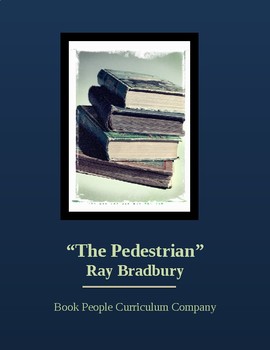

The viewers can experience the outside world without ever having to leave their home, eliminating the need to set foot outdoors almost entirely. The light which “touch faces without really touching them” evokes the uncanny moment in which the eerily similar depiction of reality through the television screen demands their attention more than the real thing itself.

However, at night, the narrator mentions that, “ill-lit by television light, … the people sat like the dead, the gray or multicolored lights touching their expressionless faces but never really touching them,” (193). By subjecting the civilians to such powerful technology, the government eliminates half a day of unpredictable civilian activity, maintaining absolute control until nighttime. The narrator of “The Pedestrian” describes the town by explaining that, “Everything went on in the tomblike houses at night now.,” (193). Leonard Mead’s society mediates experience through television screens, which reduces the lives of the civilians to uncanny, all-consuming technology. Moreover, the corrupt governments behind these stories utilize this technology as not only a means of suppressing their civilians, but also as a medium for jingoistic propaganda. Both works depict dystopian societies where immersive technology is the apex of day-to-day life from entertainment to communication to fields of work, people live through technology as much as they live by it.
#THE PEDESTRIAN SHORT STORY MOVIE#
Sleepdealer is a science fiction movie directed by Alex Rivera in 2008 that centers on Memo, a man searching for work, in a futuristic Tijuana that runs on virtual labor and remote connectivity.


Set in 2131, the narrative follows an outcast by the name of Leonard Mead as he wanders aimlessly through a town of reclusive TV-watchers. “The Pedestrian” is a science fiction short story published by Ray Bradbury in 1951. A common example of this is punishing or rewarding certain behaviors and virtually brainwashing civilians into submission, and two works that epitomize these strategies are “The Pedestrian” and Sleepdealer. Historically, some governments strive for as much control over their civilians as possible, however the methods by which they attain control vary vastly. 2. The Shape of Spiritual Trajectory in Augustine’s Confessions and Perpetua’s Diaryģ. Nabokov and Nida: Polar Opposite Approaches to TranslationĤ. Killing Individuality: Urban Design in Dystopian Fictionĥ. Dystopia and Violence in the Hunger Games TrilogyĦ. Governmentertainment: Control and Jingoistic Entertainment in “The Pedestrian” and Sleepdealerħ. Annihilation and Subversion of the Colonial Gazeġ0. Pérez’s Subtlety: Art in JLA/Avengersġ1. Spiritual Embodiment: The Divine Power of Medieval Female Mysticsġ2. Rewriting Edgar Allan Poe’s “The Fall of the House of Usher”ġ3. The Buildings of My Spirituality: A Critical Introductionġ6. Patriarchal Trauma: Rewriting the WorldĬomplit 131 Brave New World Marina Goldman


 0 kommentar(er)
0 kommentar(er)
